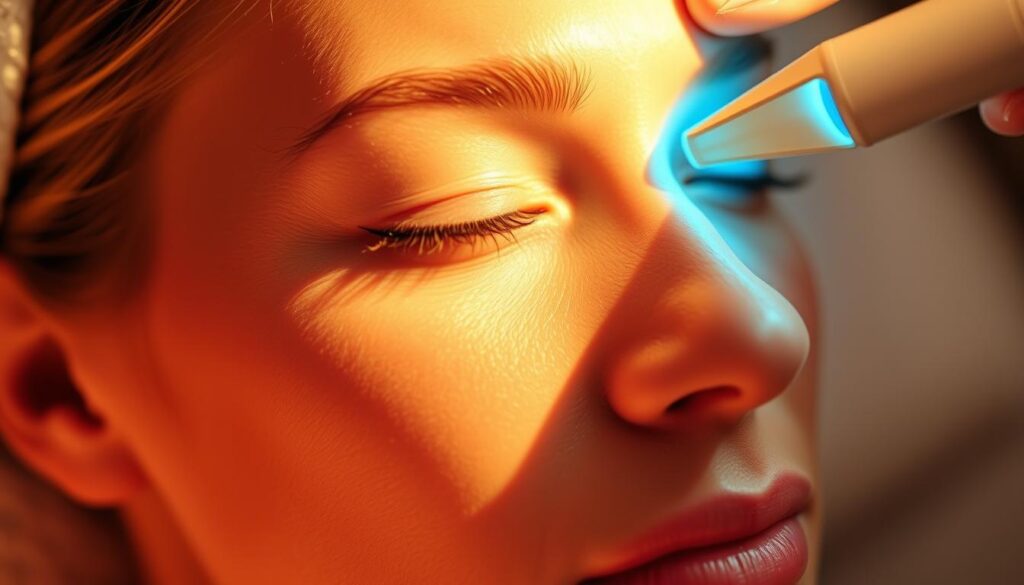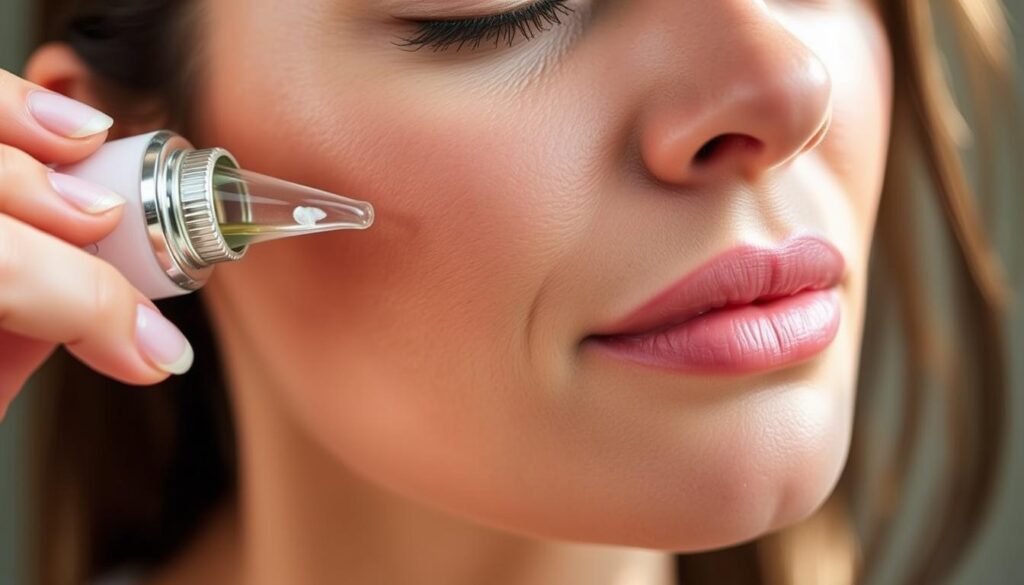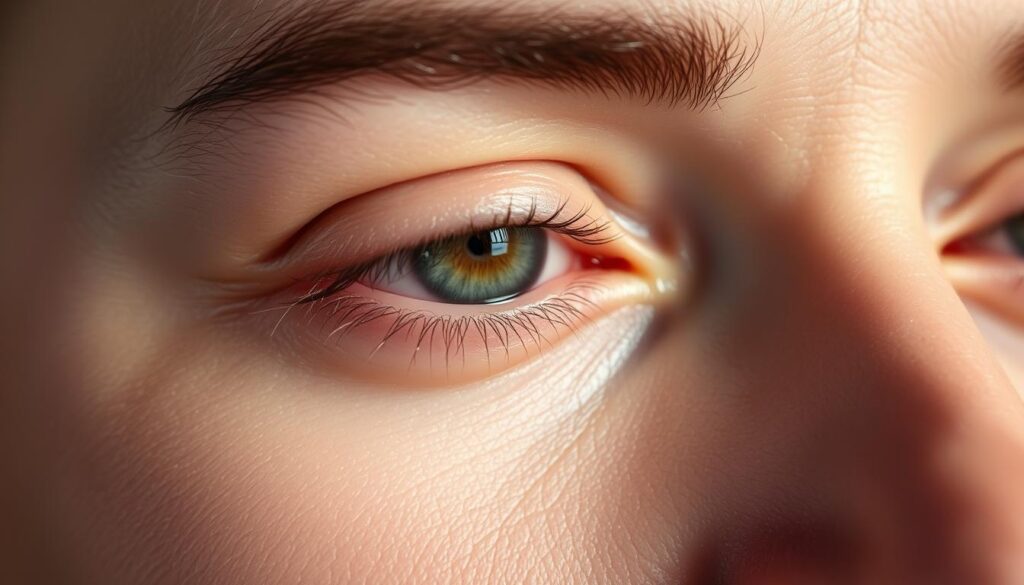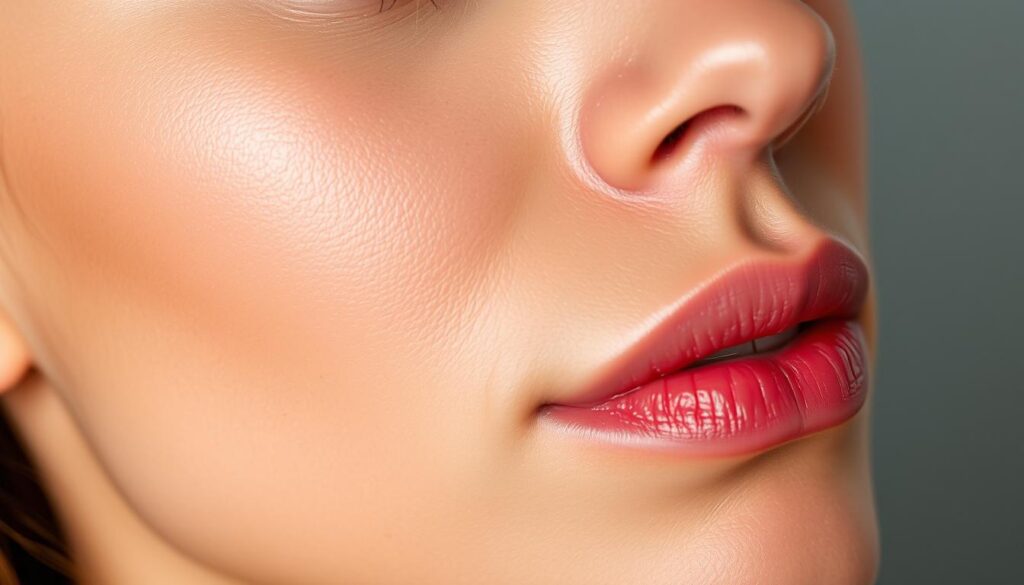As we age, our skin naturally undergoes changes. One of the earliest signs of aging is the appearance of fine lines and wrinkles. These subtle creases and folds can form on the face, neck, hands, and arms, becoming more noticeable over time1.
Collagen, a key protein in the skin, begins to decline by about 1% each year starting in your 30s. This loss, combined with reduced elasticity, contributes to the formation of wrinkles1. Factors like sun exposure, smoking, and facial muscle contractions can accelerate this process2.
This guide will walk you through practical steps to prevent and treat these signs of aging. From daily skincare routines to advanced treatments, you’ll discover options that suit your needs. Whether it’s using sunscreen to protect your skin or exploring treatments like hyaluronic acid fillers, we’ve got you covered3.
Ready to take control of your skin’s health? Let’s dive into the science-backed strategies to maintain a youthful and radiant appearance.
Introduction to Your How-To Guide
Your skin’s health is a reflection of your lifestyle and habits. This guide is designed to help you understand the steps you can take to maintain a youthful and radiant appearance. Whether you’re looking to prevent early signs of aging or explore treatment options, we’ve got you covered.
What You’ll Learn
In this guide, you’ll discover practical ways to care for your skin. From daily habits like using sunscreen to advanced treatments such as hyaluronic acid fillers, we’ll explore a range of options. You’ll also learn about the factors that contribute to skin aging, including sun exposure and smoking4.
Here’s a quick overview of what’s ahead:
- Understanding the early signs of aging on your face and body.
- Daily skincare routines to protect and improve your skin’s texture.
- Exploring both non-invasive and invasive treatment options.
Why Prevention Matters
Taking early steps to care for your skin can make a significant difference. Sun damage, for example, is a major factor in the development of wrinkles. Using sunscreen with an SPF of 30 or higher is one of the simplest ways to protect your skin4.
Smoking and alcohol consumption can also accelerate the aging process. These habits reduce blood supply to the skin and lead to dehydration, making wrinkles more likely to form4. By adopting healthy habits now, you can set the stage for long-term skin health.
| Preventive Measure | Benefit |
|---|---|
| Daily Sunscreen Use | Protects against UV damage and prevents wrinkles4. |
| Hydration | Keeps skin elastic and reduces the appearance of fine lines. |
| Antioxidant-Rich Products | Fights free radicals and improves skin texture. |
By understanding these factors and taking action, you can maintain your skin’s health and appearance for years to come. Let’s dive deeper into the science-backed strategies in the next sections.
Understanding Fine Lines and Wrinkles
Your skin tells a story, and the first chapters often include subtle changes. These changes, like fine lines and wrinkles, are natural but can be managed with the right care. Recognizing them early is key to maintaining a youthful appearance.
Defining Fine Lines vs. Wrinkles
Fine lines are the earliest signs of aging. They are shallow and often appear around the eyes and mouth. Wrinkles, on the other hand, are deeper and more noticeable. They form over time due to repeated facial movements and the loss of collagen and elasticity5.
For example, crow’s feet are fine lines that appear when you smile. Deeper wrinkles, like frown lines, develop from repeated expressions and muscle use6. Understanding these differences helps you choose the right skincare routine or treatment options.
Identifying Early Signs on Your Skin
Early signs of aging often show up in delicate areas. The skin around your eyes and mouth is thinner, making it more prone to changes. Look for small creases or a slight loss of firmness. These are your skin’s way of signaling it’s time to take action7.
Sun exposure and lifestyle habits can speed up these changes. Using sunscreen daily and staying hydrated are simple ways to protect your skin5. By identifying these signs early, you can address them before they become more pronounced.
Knowing the difference between fine lines and wrinkles empowers you to make informed choices. Whether it’s a hydrating cream or a professional treatment, you have options to keep your skin looking its best.
Causes of Skin Aging and Wrinkle Development
The journey of your skin’s aging process is influenced by both natural and external factors. Understanding these causes can help you take steps to maintain a youthful appearance. Let’s explore the key contributors to skin aging and wrinkle formation.
Internal Factors: Aging and Collagen Loss
Aging is a natural process that affects your skin’s structure. Over time, your body produces less collagen, a protein essential for maintaining skin elasticity and firmness8. This decline starts as early as your 30s and leads to slower skin cell production and thinning of the dermis8.
As the network of collagen and elastin fibers loosens, depressions on the skin’s surface become more pronounced8. Additionally, aging skin retains less moisture and produces less oil, which contributes to the development of wrinkles8.
External Factors: Sun Damage, Smoking, and Environment
External factors can accelerate the aging process. Sun exposure is a major culprit, as UV radiation breaks down collagen fibers and leads to photoaging8. The enzyme metalloproteinase, produced in response to UV damage, can cause improper collagen formation, further damaging the skin8.
Smoking reduces new collagen production, which is crucial for maintaining skin elasticity8. Environmental pollutants, such as particulate matter and nitrogen dioxide, also contribute to collagen breakdown and increased wrinkle formation8.
| Factor | Impact on Skin |
|---|---|
| Aging | Reduces collagen and elastin, leading to thinner skin8. |
| Sun Exposure | Breaks down collagen, causing photoaging8. |
| Smoking | |
| Pollutants | Damages collagen, increasing wrinkle formation8. |
By understanding these causes, you can make informed choices to protect your skin. Whether it’s avoiding smoking or using sunscreen, small changes can make a big difference.
Fine Lines and Wrinkles: Prevention and Treatment
Taking care of your skin daily can make a lasting difference in its health and appearance. Simple, consistent habits can help you maintain a smooth and youthful complexion. Let’s explore practical techniques to keep your skin looking its best.

Effective Daily Prevention Techniques
Start with a proper cleansing routine. Removing dirt, oil, and makeup residue is essential to keep your pores clear and prevent breakouts. Use a gentle cleanser that suits your skin type to avoid irritation9.
Hydration is key to maintaining your skin’s elasticity. Drink plenty of water throughout the day and use a moisturizer that locks in moisture. Products with hyaluronic acid are particularly effective in keeping your skin plump and hydrated10.
Sun protection is non-negotiable. Broad-spectrum sunscreen with an SPF of 30 or higher shields your skin from harmful UV rays, which cause 80% of skin aging9. Apply it every morning, even on cloudy days, to prevent premature wrinkles.
- Cleanse daily to remove impurities and prepare your skin for other products.
- Moisturize regularly to maintain hydration and improve texture.
- Use sunscreen to protect against UV damage and keep your skin healthy.
Incorporate gentle, science-backed products into your routine. Look for ingredients like retinol and antioxidants, which help reduce the appearance of fine lines and improve overall skin health10.
By adopting these habits, you can protect your skin and maintain a youthful appearance. Small changes today can lead to significant results over time.
Daily Skincare and Lifestyle Adjustments
Your daily habits play a significant role in maintaining healthy and youthful skin. Small, consistent steps can protect your skin from damage and keep it looking its best. Let’s explore how hydration, moisturizing, and sunscreen use can make a difference.
Hydration, Moisturizing, and Sunscreen Use
Hydration is essential for maintaining your skin’s elasticity and smoothness. Drinking plenty of water helps keep your skin plump and reduces the appearance of fine lines. Pair this with a quality moisturizer to lock in moisture and improve texture11.
Using sunscreen daily is one of the most effective ways to protect your skin. Broad-spectrum sunscreen with an SPF of 30 or higher shields against harmful UV rays, which cause 90% of skin damage12. Reapply every two hours, especially if you’re outdoors, to ensure continuous protection11.
- Cleanse gently to remove impurities without stripping natural oils.
- Moisturize daily to maintain hydration and improve skin health.
- Apply sunscreen every morning, even on cloudy days.
Healthy Habits to Protect Your Skin
Your lifestyle choices can significantly impact your skin’s appearance. A balanced diet rich in fruits, vegetables, and lean proteins supports skin health. Studies suggest that foods high in antioxidants can improve your skin’s texture and reduce signs of aging12.
Managing stress and getting 7-8 hours of sleep each night also contribute to a radiant complexion. Stress management techniques like mindfulness and physical activity can improve your overall skin health11.
Finally, avoid smoking and limit alcohol consumption. Smoking narrows blood vessels, reducing oxygen and nutrients essential for healthy skin11. Alcohol can cause permanent damage to blood vessels, leading to a flushed appearance12.
By adopting these habits, you can protect your skin and maintain a youthful glow. Small changes today can lead to lasting results over time.
Invasive and Non-Invasive Treatment Options
Exploring the right treatment options can help you achieve smoother, younger-looking skin. Whether you prefer non-invasive methods or are considering more advanced procedures, there are solutions tailored to your needs. Let’s dive into the details of popular treatments and how they work.
Non-Invasive Procedures: Micro-Needling and Chemical Peels
Non-invasive treatments have seen a 90% increase in popularity over the last nine years, according to the American Society of Plastic Surgery13. These methods are effective for reducing the appearance of fine lines and improving skin texture.
Micro-needling involves tiny needles that create micro-injuries in the skin. This process stimulates collagen production, helping to smooth out wrinkles and improve elasticity13. Results are noticeable after a few sessions, with minimal downtime.
Chemical peels use acids like glycolic or lactic acid to remove the top layer of skin. This reveals fresher, smoother skin underneath and can reduce the appearance of fine lines13. Peels come in various strengths, from mild to deep, depending on your skin’s needs.
Understanding Invasive Treatments: Fillers and Facelifts
For deeper or static wrinkles, invasive treatments like fillers and facelifts may be more effective. These procedures provide longer-lasting results but require careful consideration and consultation with a healthcare professional.
Fillers, such as hyaluronic acid-based products, add volume to the skin, smoothing out wrinkles and restoring a youthful appearance. Results can last between 6 to 12 months, depending on the type of filler used14.
Facelifts are surgical procedures that tighten loose skin and underlying tissues. They are ideal for significant sagging and provide results that can last for years14. However, they involve longer recovery times and higher costs compared to non-invasive options.
Choosing the right treatment depends on your skin’s condition and your goals. Always consult with a qualified professional to determine the best option for you. Whether you opt for a quick micro-needling session or a more comprehensive facelift, these treatments can help you achieve the results you desire.
Choosing the Right Product for Your Skin
Selecting the right skincare product can transform your daily routine. With so many options available, it’s essential to focus on the ingredients that deliver real results. Understanding what to look for can help you make informed choices and improve your skin’s texture and appearance.
Key Ingredients to Look For
When choosing a product, start by checking the label for proven actives. Retinoids are a standout ingredient, known for their ability to boost collagen and elastin production. This helps reduce the appearance of lines and supports healthier skin over time15.
Hyaluronic acid is another powerhouse ingredient. Its dual molecular weights provide deep hydration while improving surface-level moisture. This makes it ideal for plumping the skin and smoothing out fine lines16.
Other beneficial ingredients include:
- Vitamin C: Fights oxidative stress and brightens the skin15.
- Peptides: Support skin repair and elasticity.
- Antioxidants: Protect against environmental damage.
How Retinoids and Hyaluronic Acid Improve Texture
Retinoids work by activating collagen production, which helps restore firmness and reduce the appearance of wrinkles. Regular use can lead to noticeable improvements in skin texture within three months15.
Hyaluronic acid, on the other hand, hydrates the skin at multiple levels. Its ability to retain moisture makes it a go-to ingredient for reducing dryness and improving overall texture16.
When evaluating products, look for formulations that combine these ingredients for maximum benefits. Always check for labels that indicate hypoallergenic and non-comedogenic properties to ensure compatibility with your skin type16.
By focusing on these key ingredients, you can choose products that truly enhance your skin’s health and appearance. Small, informed changes in your routine can lead to lasting results.
Conclusion
Maintaining youthful skin starts with understanding its needs. Recognizing the difference between fine lines and deeper wrinkles is the first step. Both internal factors like aging and external elements such as sun exposure play a role in this natural process17.
Daily habits, like using sunscreen and staying hydrated, can protect your skin from damage. For those seeking more advanced solutions, treatments like retinoids or fillers can improve texture and reduce the appearance of wrinkles18.
By adopting a consistent routine and making informed choices, you can enhance your skin’s health over time. Start today to see lasting results and maintain a radiant, youthful appearance.



